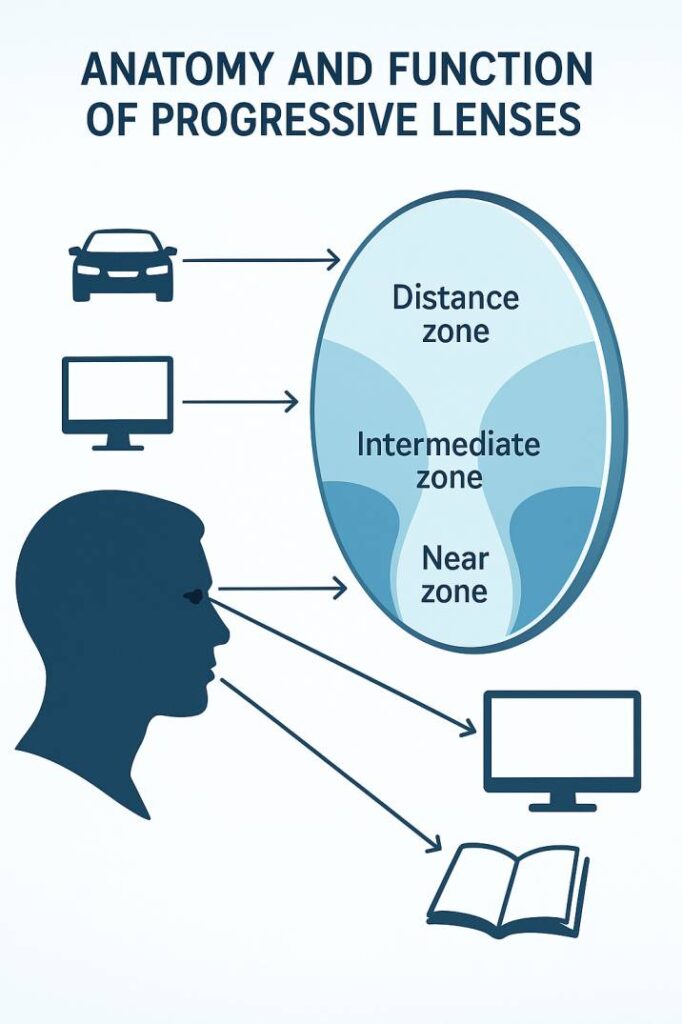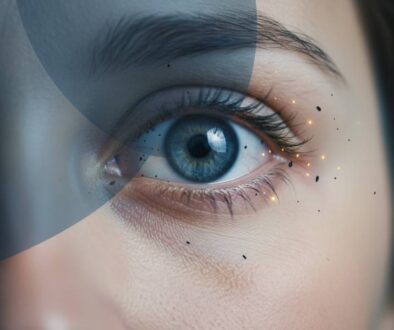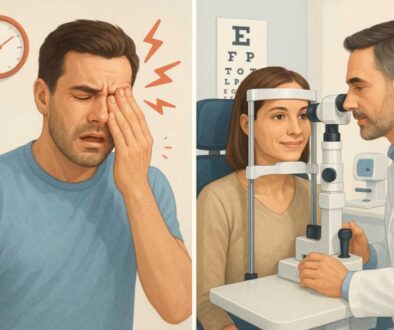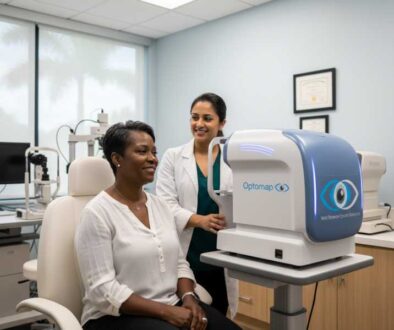Progressive or Bifocal Lenses? Expert Comparison & Advice
At a Glance: Progressive lenses offer seamless, line-free vision correction at all distances, making them ideal for today’s digital lifestyles. Bifocals provide reliable, cost-effective correction for distance and reading vision. Your optimal choice depends on lifestyle needs, budget considerations, and aesthetic preferences—factors we’ll explore in detail throughout this guide.
The Vision Challenge: Understanding Presbyopia in Modern Life
Picture this: you’re reading a restaurant menu and instinctively stretch your arm to bring the text into focus. Sound familiar? If you’re over 40, you’re likely experiencing presbyopia—a natural aging process affecting 128 million Americans, representing nearly 90% of adults over age 45.
Presbyopia occurs when your eye’s natural lens loses flexibility, making it increasingly difficult to focus on close objects. This isn’t a disease or vision defect—it’s simply how our eyes age. The good news? Multifocal lenses offer sophisticated solutions that can restore clear vision at every distance.
At West Broward Eyecare Associates, we’ve helped thousands of patients navigate this transition. The choice between progressive lenses and bifocals isn’t just about vision correction—it’s about maintaining your quality of life, professional performance, and personal confidence.
Progressive Lenses: The Modern Solution
Progressive lenses represent the pinnacle of multifocal lens technology. Often called “no-line multifocals,” these sophisticated lenses eliminate the visible lines associated with traditional bifocals while providing seamless vision correction across all distances.
The Engineering Behind Progressive Lenses
Progressive lenses incorporate three distinct vision zones within a single lens:
Distance Zone (Upper Portion)
- Optimized for driving, television viewing, and distance activities
- Provides crisp, clear vision for objects beyond 20 feet
- Maintains natural head positioning for comfortable long-distance viewing
Intermediate Zone (Middle Section)
- Perfect for computer work, dashboard viewing, and arm s-length tasks
- Addresses the growing need for digital device comfort
- Supports modern lifestyles requiring extensive screen interaction
Near Zone (Lower Portion)
- Designed for reading, smartphone use, and detailed close work
- Provides comfortable magnification for fine print and intricate tasks
- Reduces eye strain during prolonged near-vision activities
How Progressive Technology Works
Unlike bifocals with their abrupt prescription changes, progressive lenses use advanced freeform technology to create gradual transitions between vision zones. This sophisticated manufacturing process produces a lens surface with continuously varying power, mimicking your eye’s natural focusing ability.
The result? Visual transitions feel natural and seamless, eliminating the jarring “image jump” that many bifocal wearers experience when shifting focus between distances.
Key Benefits of Progressive Lenses
Aesthetic Excellence No visible lines create a youthful, modern appearance that doesn’t advertise your need for reading assistance.
Comprehensive Vision Coverage Clear sight at near, intermediate, and far distances means one pair of glasses handles every visual task.
Enhanced Depth Perception. Natural head and eye movement patterns preserve spatial awareness and improve safety during activities like driving or sports.
Professional Versatility Seamlessly transition between computer work, presentations, and client interactions without changing glasses or adjusting head position dramatically.
Bifocal Lenses: Time-Tested Reliability
Bifocals have been helping people see clearly for over 300 years, evolving from Benjamin Franklin’s ingenious invention into today’s precision-engineered solutions. These lenses provide two distinct prescription areas separated by a visible line.
Bifocal Design Elements
Upper Segment (Distance Vision)
- Corrects nearsightedness, farsightedness, and astigmatism for distance viewing
- Optimal for driving, watching television, and general daily activities
- Provides wide, unobstructed fields of view for distance tasks
Lower Segment (Near Vision)
- Dedicated reading area with magnification for close work
- Typically positioned to align with natural downward gaze when reading
- Available in various shapes and sizes to accommodate different needs
Visible Dividing Line
- Clear demarcation between distance and near prescriptions
- Allows for immediate, predictable vision zones
- Some find this line aesthetically unappealing, while others appreciate the clear distinction.
Types of Bifocal Designs
Flat-Top Bifocals (D-Segment) The most popular design, featuring a D-shaped reading area. Available in 28mm and 35mm widths to accommodate different reading preferences and frame sizes.
Round Segment Bifocals feature a circular near-vision area, offering a more traditional appearance with excellent reading comfort.
Executive Bifocals The reading segment extends across the entire lens width, providing maximum near-vision area for extensive close work.
Bifocal Advantages
Immediate Clarity Instant, predictable focus in both distance and near zones without adaptation challenges.
Wider Reading Areas: Larger near-vision zones compared to progressives, beneficial for extensive reading or detailed work.
Proven Reliability Decades of refinement have produced consistently effective, dependable vision correction.
Cost Effectiveness: Generally 30-50% less expensive than progressive lenses, making quality vision correction more accessible.
Head-to-Head Comparison: Progressive vs. Bifocal Lenses
Vision Quality and Performance
Progressive Lenses Excel In:
- Seamless transitions between all viewing distances
- Superior computer and digital device use
- Natural visual flow for dynamic activities
- Elimination of image jump between focal zones
Bifocals Excel In:
- Immediate, sharp focus in designated zones
- Wider reading areas for extensive close work
- Predictable vision zones without peripheral distortion
- Consistent performance across all lighting conditions
Adaptation and Comfort Considerations
Progressive Lens Adaptation Modern progressive lenses achieve remarkable success rates when properly fitted. Clinical studies show 97% of participants successfully adapt to progressive lenses fitted with advanced measurement techniques. The typical adaptation period spans 1-3 weeks, during which users may experience:
- Mild peripheral distortion while the brain adapts
- Need to learn optimal head positioning for different tasks
- Temporary spatial disorientation in some individuals
Bifocal Adaptation generally requires 3-7 days for full adaptation. The distinct vision zones make the learning curve more straightforward, though users must develop proper head positioning habits for reading.
Lifestyle Compatibility
Choose Progressive Lenses If You:
- Work extensively with computers or digital devices
- Value aesthetic appearance and modern lens technology
- Need clear intermediate vision for varied daily activities
- Can commit to the adaptation period for long-term benefits
- Engage in dynamic activities requiring seamless vision transitions
Choose Bifocals If You:
- Have straightforward distance and reading vision needs
- Prefer immediate, predictable vision correction
- We are working within budget constraints
- Want proven, time-tested technology
- Need very wide reading areas for extensive close work
Investment Analysis
Progressive Lenses: Premium Investment. Typically range from $150-600+, depending on lens technology and coatings. Premium options with digital surfacing and customization offer superior optical performance but command higher prices.
Bifocals: Value-Conscious Choice Usually cost $70-250, making them an excellent entry point for presbyopia correction or backup glasses.
Important Note: While progressives require higher upfront investment, their versatility may eliminate the need for multiple pairs of glasses, potentially offering better long-term value.
Making Your Decision: A Strategic Framework
Professional Assessment Factors
Lifestyle Analysis
- Occupational visual demands (office work, outdoor activities, detailed tasks)
- Digital device usage patterns and duration
- Hobbies and recreational activities requiring specific vision needs
- Social and aesthetic preferences
Visual Health Evaluation
- Current prescription strength and stability
- Binocular vision function assessment
- Previous multifocal experience and adaptation success
- Age-related vision changes and progression patterns
Decision-Making Questions
Consider these key questions during your consultation:
- “How much time do you spend on computers or digital devices daily?” Heavy digital users typically benefit more from progressive lenses’ intermediate zone.
- “Do you frequently switch between different visual tasks?” Dynamic lifestyles favor progressive lenses’ seamless transitions.
- “How important is the aesthetic appearance of your glasses?” If visible lines concern you, progressive lenses offer superior cosmetic appeal.
- “What’s your budget for this vision correction investment?” Bifocals provide excellent value, while progressives offer premium features.
- “Have you worn multifocal lenses before?” Previous experience can influence adaptation success and lens selection.
Recent Advances in Multifocal Technology
AI-Powered Lens Design
The latest progressive lenses incorporate artificial intelligence to optimize lens design based on individual wearing patterns and behavioral data. This technology creates more personalized visual experiences with faster adaptation times and improved optical performance.
Digital Eye Strain Solutions
Modern multifocal lenses increasingly feature specialized coatings and optical designs to combat digital eye strain. These innovations address the growing concern of blue light exposure and screen-related visual fatigue.
Advanced Customization
Cutting-edge measurement techniques, including foveal fixation axis mapping, are revolutionizing progressive lens fitting. Studies demonstrate that these personalized fitting methods achieve 92% of wearers reporting clear vision when using smartphones and computers with adaptive progressive lenses.
Professional Fitting: The Foundation of Success
The Importance of Expert Measurement
Whether choosing progressive lenses or bifocals, professional fitting determines your success. Critical measurements include:
Pupillary Distance (PD) ensures optical centers align perfectly with your pupils for optimal vision quality.
Segment Height and Progressive Corridor
Position reading areas and transition zones according to your natural gaze patterns.
Frame Fit and Positioning. Proper temple and bridge fit affects lens performance and wearing comfort.
Lifestyle Assessment: Understanding your visual demands guides lens selection and customization options.
What to Expect During Professional Fitting
At West Broward Eyecare Associates, our comprehensive fitting process includes:
- Complete Vision Assessment: Thorough refraction and binocular vision evaluation to determine exact prescription needs.
- Lifestyle Consultation
In-depth discussion of your daily visual tasks, challenges, and goals. - Frame Selection Guidance: Choosing frames that optimize lens performance while matching your style preferences.
- Precision Measurements: Advanced fitting parameters using the latest measurement technology.
- Follow-up Support: Ensuring proper adaptation with adjustment appointments and ongoing care.
Evidence-Based Effectiveness
Clinical Research Findings
Recent studies provide compelling evidence for multifocal lens effectiveness:
Progressive Lens Success Rates Research with aviators demonstrated that progressive lenses significantly improved target detection speed at intermediate distances compared to bifocals, highlighting practical advantages for complex visual tasks.
Adaptation Research Clinical trials show 97% of participants successfully adapted to progressive lenses when fitted with proper measurement techniques, with high satisfaction rates across all user groups, including first-time multifocal wearers.
User Satisfaction Metrics Studies from 2024 show that 92% of wearers reported clear vision when using smartphones and computers with adaptive progressive lenses, with significant improvements in visual satisfaction scores after 30 days of wear.
Market Growth and Innovation
The multifocal lens market, valued at $5.61 billion in 2023 and projected to reach $9.55 billion by 2030 (growing at 7.9% annually), reflects increasing consumer adoption and technological advancement.
For those considering contact lens alternatives, multifocal contact lens prescribing has more than doubled over two decades, reaching 61.1% of presbyopic contact lens fits in 2023, demonstrating broader acceptance of multifocal vision correction approaches.
Addressing Common Concerns
“Will I Successfully Adapt to Progressive Lenses?”
Research shows that 34.8% of non-users cite lack of awareness about progressive lenses as the primary barrier, while 15.9% mention adaptation concerns. However, when properly fitted, 97% of participants successfully adapt according to clinical studies.
Most initial discomfort resolves within 2-3 weeks as your brain learns to optimize the different lens zones effectively.
“Are Bifocals Becoming Outdated?”
While progressive lenses represent newer technology, bifocals remain highly effective for many individuals. They offer reliable vision correction with predictable performance and continue to be an excellent choice for specific needs and budget considerations.
“Which Option Provides Better Long-term Value?”
Both lens types offer similar durability when properly maintained. Value depends more on how well the lens type matches your lifestyle and visual needs rather than the basic lens design.
Care and Maintenance Best Practices
Daily Care Routine
Lens Cleaning
- Use microfiber cloths and appropriate lens cleaning solutions daily
- Avoid paper towels or clothing that can scratch anti-reflective coatings
- Clean both sides of the lenses with gentle circular motions
Proper Storage
- Always use protective cases when glasses aren’t being worn
- Avoid leaving glasses in hot cars or extreme temperatures
- Keep backup glasses in convenient locations
Handling Precautions
- Hold glasses by the frames, not the lenses
- Use both hands when putting on or removing glasses
- Avoid placing glasses down on surfaces
When to Consider Replacement
Prescription Changes Regular eye exams (typically every 1-2 years) may reveal prescription changes requiring new lenses.
Physical Damage: Significant scratches, chips, or frame damage can compromise vision quality and safety.
Coating Deterioration: Anti-reflective and other specialty coatings may degrade over time, affecting visual clarity.
The Future of Multifocal Vision Correction
Emerging Technologies
The progressive lens industry continues innovating with developments including:
Smart Lens Integration Research into lenses with embedded sensors for health monitoring and augmented reality applications.
Enhanced Digital Optimization
Advanced algorithms are creating more personalized lens designs based on real-world wearing patterns.
Sustainable Materials Development of eco-friendly lens materials and manufacturing processes addressing environmental concerns.
Advanced Customization, AI-driven design optimization, and creating truly personalized optical solutions for individual users.
Contact Lens Innovations
Multifocal contact lens technology continues advancing with improved materials, designs, and wearing schedules, offering additional options for presbyopic patients seeking alternatives to eyeglasses.
Your Next Steps: Making an Informed Choice
Schedule Your Comprehensive Consultation
The journey to optimal vision correction begins with a professional evaluation. During your appointment, expect:
Thorough Eye Examination: Complete assessment of your current vision, eye health, and binocular function.
Lifestyle Needs Analysis
Discussion of your daily activities, visual challenges, and personal preferences.
Technology Options Review: Explanation of available lens technologies, coatings, and customization options.
Cost and Insurance Discussion: Clear explanation of investment options and insurance coverage details.
Questions for Your Eye Care Professional
- “Based on my specific visual needs and lifestyle, which lens type do you recommend and why?”
- “What should I expect during the adaptation period, and what support do you provide?”
- “Are there specific frame requirements that will optimize my chosen lens performance?”
- “What follow-up care is included, and how do you ensure my satisfaction?”
- “Can you explain the warranty and adjustment policies for my investment?”
References and Further Reading
1. Clinical Research on Progressive Lens Effectiveness
Visual satisfaction with progressive addition lenses prescribed with novel foveal fixation axis measurements
Scientific Reports – Nature Publishing Group
https://www.nature.com/articles/s41598-023-38446-6
This peer-reviewed study demonstrates that 97% of participants successfully adapted to progressive lenses when fitted with advanced foveal fixation axis measurements, providing strong clinical evidence for the effectiveness of modern progressive lens fitting techniques across all user groups, including neophytes and previous unsuccessful users.
2. Market Analysis and Industry Trends
Progressive Lenses Market Analysis and Forecast (2024-2030)
Maximize Market Research
https://www.maximizemarketresearch.com/market-report/progressive-lenses-market/194107/
Comprehensive market analysis confirming the progressive lens market growth from $5.61 billion in 2023 to a projected $9.55 billion by 2030, with detailed segmentation by demographics, applications, and regional trends that support the article’s market data and growth projections.
3. Presbyopia Statistics and Demographics
For 128 Million U.S. Presbyopes, Doctors of Optometry Can Provide Treatment Options
American Optometric Association
https://www.aoa.org/news/clinical-eye-care/diseases-and-conditions/for-128-million-us-presbyopes-doctors-of-optometry-can-provide-treatment-options
Official AOA resource confirming that 128 million Americans (nearly 90% of adults over 45) are affected by presbyopia, providing authoritative demographic data and treatment options including progressive lenses, bifocals, and multifocal contact lenses.
Conclusion: Clear Vision for Your Future
The choice between progressive lenses and bifocals extends far beyond simple vision correction—it’s about enhancing your quality of life, maintaining your independence, and supporting your personal and professional goals.
Progressive lenses excel for individuals seeking comprehensive, aesthetically pleasing vision correction with seamless transitions between all distances. They’re particularly valuable for people with dynamic lifestyles requiring clear intermediate vision and those who prioritize modern appearance.
Bifocals remain an excellent choice for individuals with straightforward distance and reading needs who prefer immediate visual clarity and cost-effective solutions. Their proven track record and reliable performance make them ideal for many presbyopic patients.
Remember, the “best” lens is the one that seamlessly integrates into your life, providing comfortable vision while meeting your aesthetic and functional preferences. Neither choice is permanent—your vision needs may evolve, and lens technology continues advancing.
Your Vision, Your Choice
At West Broward Eyecare Associates, we’re committed to helping you make the decision that best serves your unique needs. Our experienced team combines cutting-edge technology with personalized care to ensure you receive the perfect lens solution.
Ready to explore your multifocal options? Contact West Broward Eyecare Associates today to schedule your comprehensive consultation. Let us help you rediscover the joy of clear, comfortable vision at every distance.
FAQs
-
Progressive lenses have no visible lines and provide seamless vision at all distances, while bifocals have a visible line for only two fields: near and far





